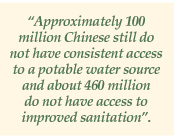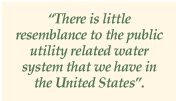By: Richard King

In the past, I have written a few columns regarding water distribution in China and focusing on four issues.
1. The uneven water distribution within the country. 80% of the total water resources are in South China.
2. The inappropriate use of water. Dirty water and water too rich in nutrients causes a severe shortage of quality water.
3. The increasing flooding and drought caused by hydrological projects.
4. The lack of water conservation and recycling programs.
In this article, I would like to focus on the value of water in China and the accessibility and distribution of water to the Chinese consumer.
Water supply in China is undergoing a huge transition due to various challenges such as, rapid urbanization and a widening gap between rich and poor in both urban and rural areas. Water scarcity contamination and pollution also are great challenges.

However, much has been achieved during the past 10 years with increased access to services, increased municipal waste water treatment and the creation of water utilities that are legally and financially separated from local governments and are increasing the recovery of cost as part of the transformation in the Chinese economy. The government quadrupled investments in the water distribution sector during the past five years. Having said that, much remains to be achieved. Approximately 100 million Chinese still do not have consistent access to a potable water source and about 460 million do not have access to improved sanitation. The progress in rural areas lags behind what has been achieved in urban areas. However, some progress and access has taken place. Between 2000 and 2009 more than 450 million Chinese gained consistent access to an approved water source. But having access to an improved water access is not the same as having access to safe water. Much of the water is poor quality due to contamination and many times water shortages occur. 60% of Chinese cities face seasonal water shortages, and over 100 cities have severe contamination.
Responsibility for the supply of water at the national level is shared between four ministries – The Ministry of Housing and Urban Rural Development (until 2008 the Ministry of construction) for urban water supply; Ministry of Health for rural water supply; Ministry of Water Resources for Water Resources Management.

Provincial governments play a relatively limited role in providing some financing for rural water supply. Local governments play a major role, providing a substantial share of financing and owning the water supply companies that are the main water providers in urban areas. In smaller towns, local government many times provide service directly, and village committees operate water systems in rural areas.
Urban water supply in China is a responsibility of cities under complex arrangements that differ widely from one city to another. Cities are usually governed by a group under the leadership of the mayor who is assisted by various bureaus and departments. Services are usually provided by municipally owned water companies, referred to as utilities.
As an example, in Shanghai, water distribution is provided by the water division of one of the large corporations. The water division includes a raw water company, five commercial water companies, and a sewage management company. The city of Shenzhen has probably the leading local water management in China. It is a model of a water utility in Hong Kong which has combined all the water related function into one agency. Also regulatory and operation function were separated. The municipal public utility in Shenzhen was outsourced to a French firm and its Chinese partner.
While there is some improvement, China still has a long way to go in providing consistent access to potable water for its population. There is little resemblance to the public utility related water system that we have in the United States and it maybe that our system may not be a good model for a country with a vast population like China. There are many companies in the San Fernando Valley and San Gabriel Valley that can provide expertise to accelerate a water distribution system in China that will be efficient and cost effective.


|